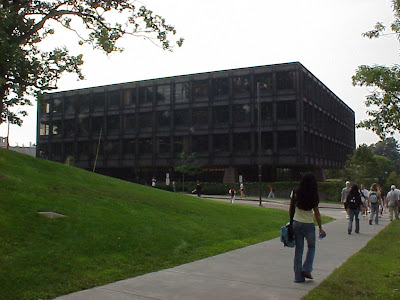Common Sense Philosophy now Less Common, or Dancing Around Architecture
 The building pictured to the right is the MIT Stata Center, which houses a couple of Computer Science and AI Laboratories, as well as the Linguistics and Philosophy departments. Designed by a Pritzker-Prize winner, the equivalent of a Nobel in the Architecture world, Frank Gehry is being sued for design and structural flaws. The building once described by Gehry as looking like a drunken robot party (I fail to understand why this would be a reasonable design concept, unless they were of course...girl robots), the flaws have caused such problems as mold appearing in the amphitheater due to a poor drainage system and some masonry cracking. The court papers also complain about sliding ice and snow. Sliding ice and snow, really, is this really a surprise to anyone? Look at the building, seriously, what did they expect in Cambridge? Gehry claims that it's a result of "value engineering," code for "the Luddite Philistines don't appreciate my genius," or more xenophobically, "cheap immigrant labor." The construction company responsible for the $300 million abortion claims innocence and no philosophy professors or other faculty who have offices there, including one, Noam Chomsky, have been injured yet. MIT administrators remain on the insurance hunt warpath, common sense warpath long stopped, sometime after the Scottish Enlightenment.
The building pictured to the right is the MIT Stata Center, which houses a couple of Computer Science and AI Laboratories, as well as the Linguistics and Philosophy departments. Designed by a Pritzker-Prize winner, the equivalent of a Nobel in the Architecture world, Frank Gehry is being sued for design and structural flaws. The building once described by Gehry as looking like a drunken robot party (I fail to understand why this would be a reasonable design concept, unless they were of course...girl robots), the flaws have caused such problems as mold appearing in the amphitheater due to a poor drainage system and some masonry cracking. The court papers also complain about sliding ice and snow. Sliding ice and snow, really, is this really a surprise to anyone? Look at the building, seriously, what did they expect in Cambridge? Gehry claims that it's a result of "value engineering," code for "the Luddite Philistines don't appreciate my genius," or more xenophobically, "cheap immigrant labor." The construction company responsible for the $300 million abortion claims innocence and no philosophy professors or other faculty who have offices there, including one, Noam Chomsky, have been injured yet. MIT administrators remain on the insurance hunt warpath, common sense warpath long stopped, sometime after the Scottish Enlightenment.
The New York Times Tower designed by the 1998 winner of the Pritzker Prize, Renzo Piano, famous for his Georges Pompidou Center, is also suing the architecture firm responsible for this exposed ceramic roded cruciformed phallus. Apparently, ice forming around the rods heat slightly during the day, I know hard to believe, but this heating causes ice to fall from the sky at intense gravity accelerated, skull-damaging velocities. The structure of the building, with its glass facade has also led to two windows shattering and falling to the earth in the span of a week. This so-called green-building with its reduced environmental footprint and energy-saving features (glass still remains sharp, however) is not without its merit, but they will have to do something about the death icicles.
It is likely true that the amount of planning, testing, and redesigning that must go into these contemporary structures is mind-numbing and tedious at best. It is also that tediousness, no doubt, which generates the massive price tags on those projects. However, it is equally interesting to encounter the cracks in the foundation (pun most definitely intended), as tiny design issues on paper become massive health and safety issues in life, and legal battles in court. Though these issues are nothing new; they are becoming more common as the desire for invention and creativity quickly outstrips the human capacity to foresee, schematize, and account for every contingency.  The first such encounter for me and still one of the most head-shakingly amusing ones I have made note of is Uris Hall (pictured right), which is on the lovely campus of Cornell University in Ithaca, NY. Apparently two graduates back in the 70's from my dear Alma Mater far above Cayuga's waters decided, after making a ton of money, that they wanted to name a building after themselves, a natural impulse I guess if you are rich. In Pittsburgh they saw the U.S. Steel building, which was composed of Cor-ten steel. This type of steel was particularly resistant to corrosion due to the fact that as the surface oxidized it would develop a brownish-orange patina that would protect the metal alloy. Both impressed by the material and the color its patina produced, they asked the material to be the principle component in the building of this academic facility. Unfortunately for them but fortunately for the students and inhabitants of Cornell and the surrounding town, the air in upstate New York does not contain the sulfuric pollutants that the residents of Western Pennsylvania inhale. As a result, good air, ugly as sin rust. The building is currently a sort of splotched dark brown and black cage-like monstrosity but is in no danger of corroding. In other news: Men more like rodents than previously suspected in detailed planning tasks says a report out of Scotland. As you may have noticed, Scotland has had a long tradition with both Common Sense and the best laid plans of others, I bet their buildings don't look like drunken robot orgies.
The first such encounter for me and still one of the most head-shakingly amusing ones I have made note of is Uris Hall (pictured right), which is on the lovely campus of Cornell University in Ithaca, NY. Apparently two graduates back in the 70's from my dear Alma Mater far above Cayuga's waters decided, after making a ton of money, that they wanted to name a building after themselves, a natural impulse I guess if you are rich. In Pittsburgh they saw the U.S. Steel building, which was composed of Cor-ten steel. This type of steel was particularly resistant to corrosion due to the fact that as the surface oxidized it would develop a brownish-orange patina that would protect the metal alloy. Both impressed by the material and the color its patina produced, they asked the material to be the principle component in the building of this academic facility. Unfortunately for them but fortunately for the students and inhabitants of Cornell and the surrounding town, the air in upstate New York does not contain the sulfuric pollutants that the residents of Western Pennsylvania inhale. As a result, good air, ugly as sin rust. The building is currently a sort of splotched dark brown and black cage-like monstrosity but is in no danger of corroding. In other news: Men more like rodents than previously suspected in detailed planning tasks says a report out of Scotland. As you may have noticed, Scotland has had a long tradition with both Common Sense and the best laid plans of others, I bet their buildings don't look like drunken robot orgies.

 There are those who would claim that there exists a Church of Science and of Philosophy, insofar that these institutions are dependent on certain axiomatic principles or beliefs which cannot be challenged, much like canonical church doctrine, except through major revolutionary processes or "paradigm shifts." If indeed these cathedrals of the intellect do exist, surely we must count these "mysterians" as their most dangerous heretics. [They have come to invade the earth, abduct its women, and level the basic suppositions of a mechanistic observable universe] They are perhaps even more dangerous than those who would carry the banner of "intelligent design." All they want (though, it is admittedly far too much) is to have their books included in the liturgy and set alongside On the Origin of Species. These mysterians would have us believe that science/philosophy does not and cannot have all the answers, that in fact, (ab)solution does not lie within that Church. Yet, there is a residuum of inquiry that would seem heretofore contradictory to this ostensibly defeatist attitude. The mysterian position does compel its critic to wonder, at least minimally, if in reality there exists a "solution" to the problem of consciousness, how will we know we have found it? More fundamentally, what constitutes a solution to the problem of consciousness? In the typical hypothetico-inductive experimental method, either reproducibility or some other strict method of verification is required in order to establish sufficient confidence about a theory. Is it necessary in order for us to establish the authenticity of a theory of consciousness, must it provide a description sufficiently capable of reproducing the phenomenon? Will a definition of consciousness be able to properly account for every minute and variegated circumstance in which consciousness manifests itself? From this perspective one might consider including the mysterian position in the "big tent" of Philosophy and Science, because like most other authentic or meaningful philosophical inquiries, what it leaves us with is much like what it starts us with, a....
There are those who would claim that there exists a Church of Science and of Philosophy, insofar that these institutions are dependent on certain axiomatic principles or beliefs which cannot be challenged, much like canonical church doctrine, except through major revolutionary processes or "paradigm shifts." If indeed these cathedrals of the intellect do exist, surely we must count these "mysterians" as their most dangerous heretics. [They have come to invade the earth, abduct its women, and level the basic suppositions of a mechanistic observable universe] They are perhaps even more dangerous than those who would carry the banner of "intelligent design." All they want (though, it is admittedly far too much) is to have their books included in the liturgy and set alongside On the Origin of Species. These mysterians would have us believe that science/philosophy does not and cannot have all the answers, that in fact, (ab)solution does not lie within that Church. Yet, there is a residuum of inquiry that would seem heretofore contradictory to this ostensibly defeatist attitude. The mysterian position does compel its critic to wonder, at least minimally, if in reality there exists a "solution" to the problem of consciousness, how will we know we have found it? More fundamentally, what constitutes a solution to the problem of consciousness? In the typical hypothetico-inductive experimental method, either reproducibility or some other strict method of verification is required in order to establish sufficient confidence about a theory. Is it necessary in order for us to establish the authenticity of a theory of consciousness, must it provide a description sufficiently capable of reproducing the phenomenon? Will a definition of consciousness be able to properly account for every minute and variegated circumstance in which consciousness manifests itself? From this perspective one might consider including the mysterian position in the "big tent" of Philosophy and Science, because like most other authentic or meaningful philosophical inquiries, what it leaves us with is much like what it starts us with, a....